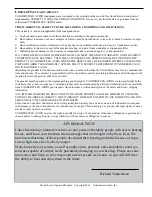
your particular tastes and the peculiarities of individual
recordings. The Model Seven’s controls were chosen
solely for their sonic characteristics and have a life expec-
tancy of hundreds rather than thousands of uses. This
should be enough to cover several lifetimes worth of resi-
dence changes or room alterations.
L
OW-
F
REQUENCY
C
ONTOUR (
Q
C
ONTROL)
The Low-Frequency Contour control adjusts the Q of
the subwoofer to accommodate different rooms, listening
tastes, or system modes. In subwoofer engineering terms,
system Q is the product of a complex mathematical equa-
tion derived from driver, electrical, and enclosure parame-
ters. In practical terms, it relates to the character of the
bass response. A low Q subwoofer sounds very tight and
controlled. A high Q subwoofer produces a warm, full
bass with more energy in the most audible bass range.
The Model Seven’s Low-Frequency Contour control is
leveled from 1 to 10. As shown in the graph below, posi-
tion # 1 provides the tightest bass (Lean Audiophile
Sound), position # 7 is maximally flat as measured at the
driver cone, (Linear Anechoic Response) and position #
10 emulates the peaked response of a typical high Q home
theater subwoofer (Big and Boomy.)
Once the room compensation controls have been set by
a qualified technician, our experience is that the bass in
most rooms sounds the most linear on high-quality music
recordings with the Low-Frequency Contour set in the # 5
to # 8 range. Contour should always be the same for both
speakers. Please remember that every room and system
are different and that the nominal position in your system
may be higher or lower due to room characteristics or per-
sonal preferences.
Once you have established the nominal setting for your
system, we recommend that you make any temporary bass
adjustments with the preamplifier’s or video processor’s
bass controls. If your system does not have tone controls
and is regularly used for home theater reproduction, we
recommend using an additional one or two V2W L.F.E.
theater subwoofers. The Low-Frequency Contour control
should be set to the best setting for two channel music as
described above. With this configuration the Model
Seven’s sub-woofer and the L.F.E. sub-woofer(s) will be
in play while watching movies. Fun!!!
H
IGH-
F
REQUENCY
L
EVEL
A
ND
C
ONTOUR
The High-Frequency controls adjust the output level and
response characteristics of the rear mounted tweeter. As
you prepare to set the rear tweeter for your room and taste,
there are some points you should consider. In most rooms,
with the speakers positioned reasonable distances from the
walls, the best setting for the rear tweeter is OFF. With the
rear tweeter turned off, the Model Seven is a perfectly
aligned, mono-polar design. Our measurements as well as
our ears convince us that this configuration provides the
best imaging, the most true detail, and the lowest distor-
tion. In some highly damped rooms however, speakers with
flat treble response can sound dead and lifeless. We believe
that in these rooms, increasing the high-frequency content
of the reverberant field is the best way to compensate for
the extreme room characteristics.
The decision to incorporate the rear tweeter into the
Model Seven was not an easy one. Even though it can pro-
duce some pleasing phasey phenomena as its output re-
flects 901 different ways off the surrounding walls, it is a
second source for the information reproduced by the direct
tweeter and therefore, its contribution to the sound field is
significantly smeared in time and technically 100% distor-
tion. (The front direct tweeter is already reproducing all of
the high-frequency information on the recording, any in-
crease above what is actually on the recording is by defini-
tion, distortion.)
In highly-damped rooms with thick carpeting, plush
furniture, and heavy drapes, activating the rear tweeter may
subjectively provide a more realistic and lifelike frequency
balance. If you decide to use the rear tweeter, set the High-
Frequency Level control at # 3 and evaluate the different
High-Frequency Contour settings with your reference re-
cordings to determine which contour settings sound the
most natural in your room. Each higher number extends the
rear tweeter’s output slightly lower in frequency as shown
in the graph below.
After you decide which contour setting provides the
best high-frequency characteristics for your room, use the
High-Frequency Level control to adjust the rear tweeter
level. Each higher number increases the output of the rear
tweeter by about 11/2dB.
If you are unable to achieve satisfactory perform-
ance using the information and procedures above,
please contact the Model Seven Customer Assis-
tance Department at Vandersteen Audio.
V
ANDERSTEEN
A
UDIO
14




















